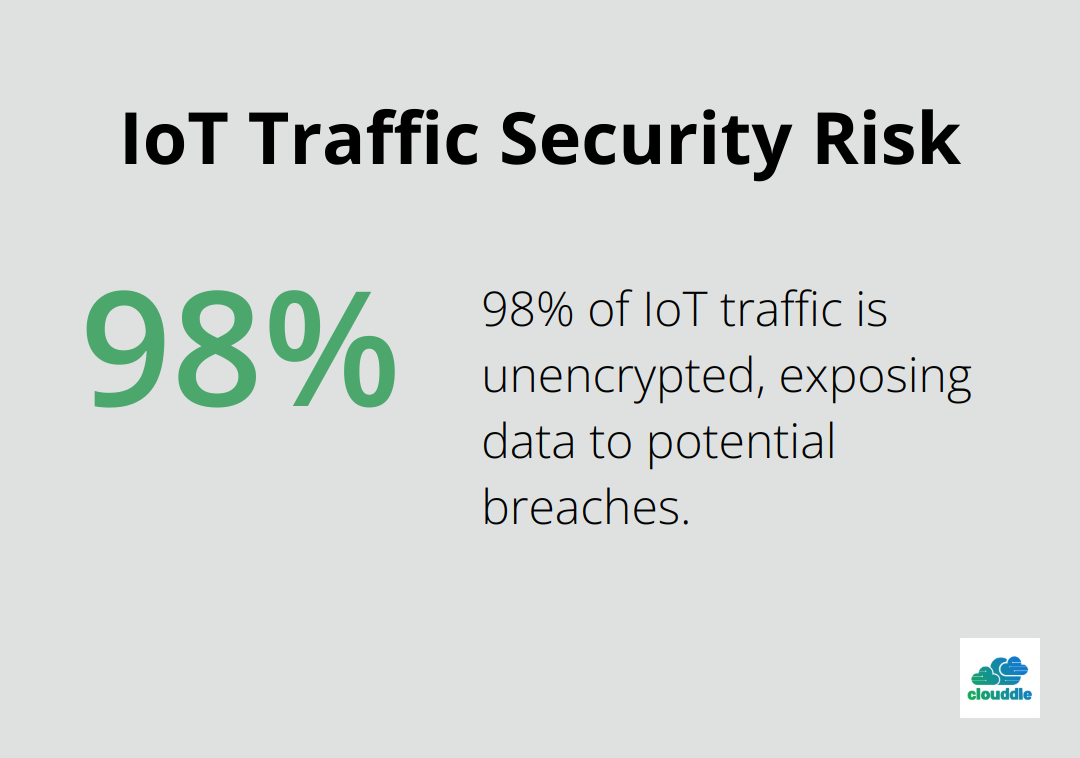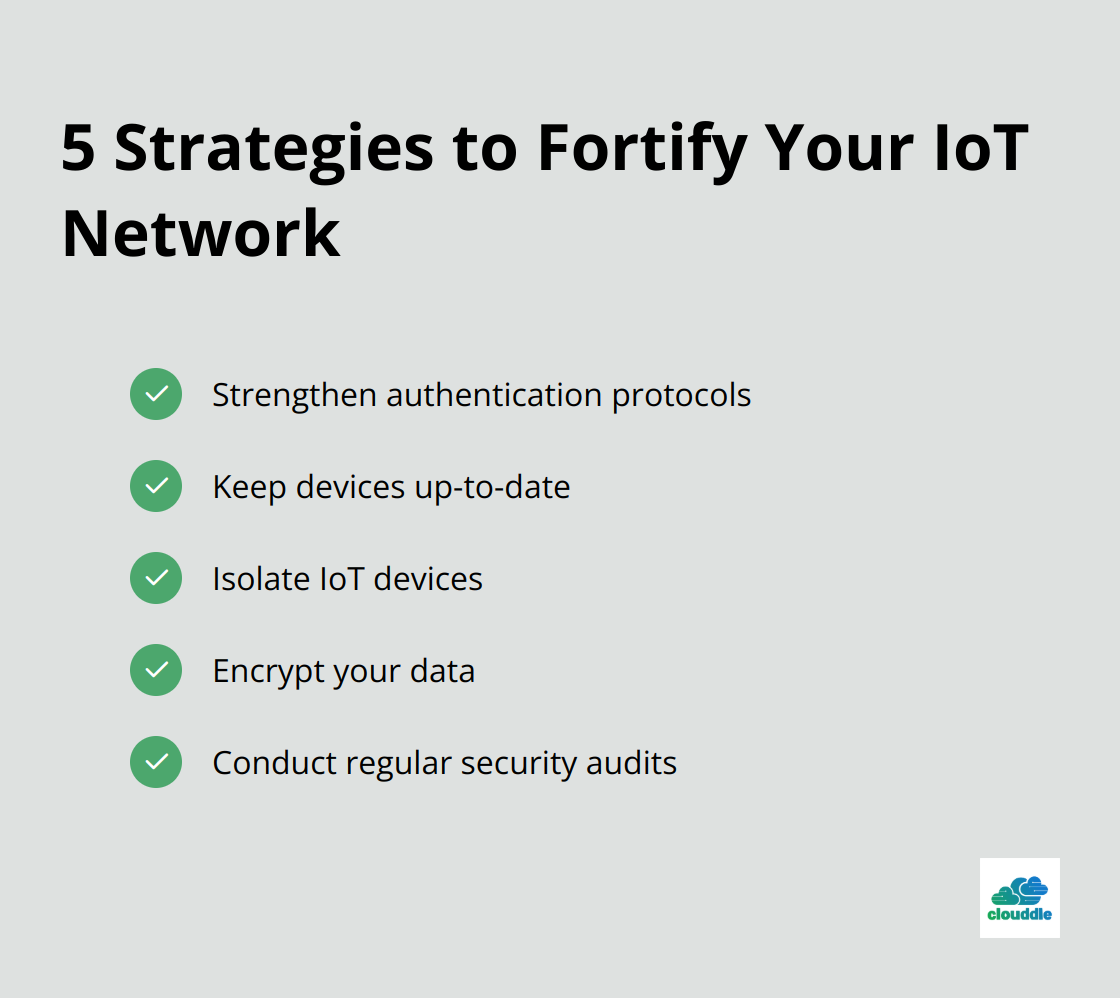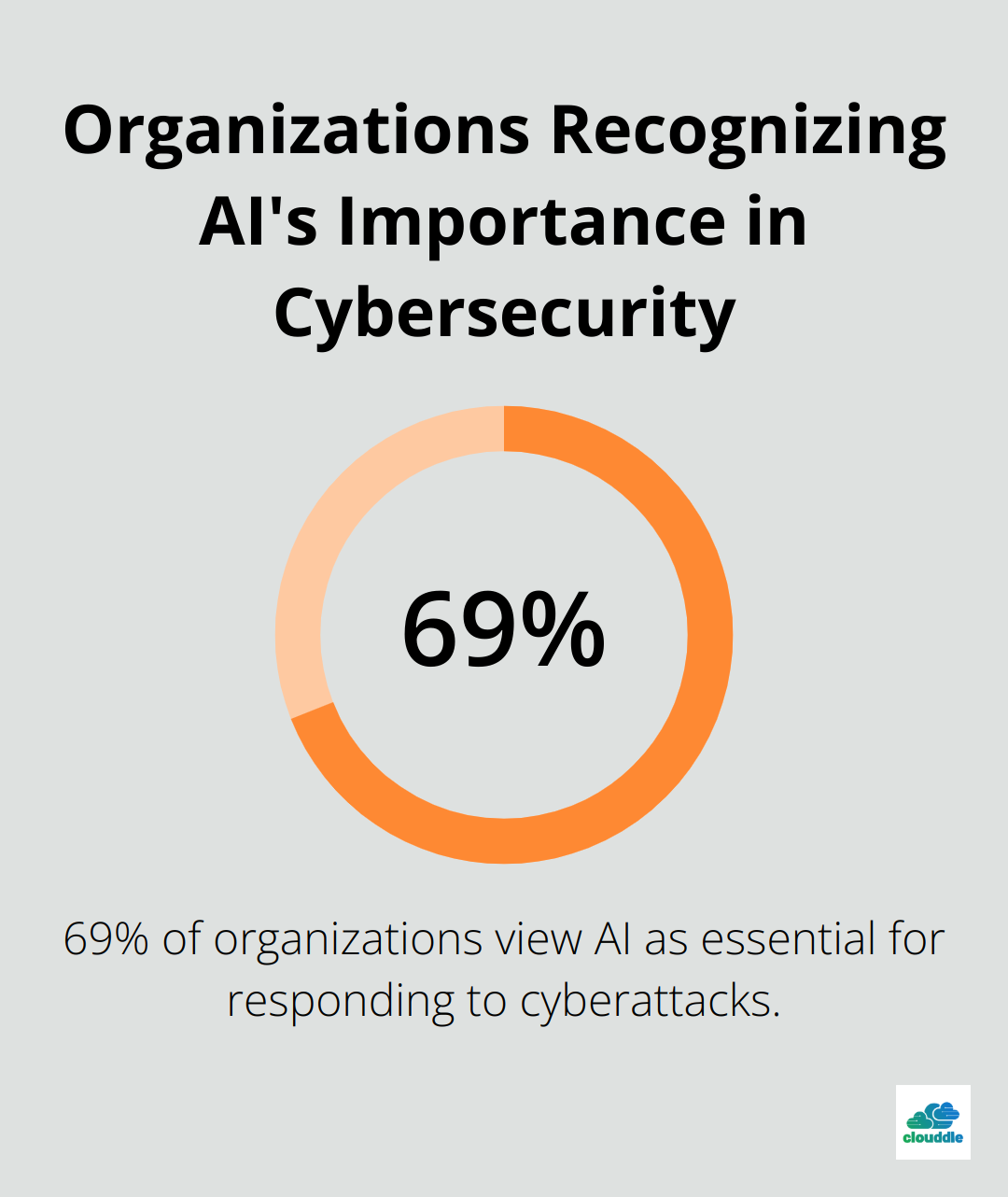IoT network security is a critical concern for businesses and individuals alike. With the rapid growth of connected devices, the potential for security breaches has skyrocketed.
At Clouddle, we’ve seen firsthand how vulnerable IoT networks can be without proper protection. This blog post will guide you through essential strategies to fortify your IoT infrastructure and safeguard your data from cyber threats.
Why IoT Networks Face Security Challenges
Inherent Vulnerabilities in IoT Devices
IoT networks have become prime targets for cybercriminals due to their unique characteristics and widespread adoption. The security landscape for IoT is fraught with challenges, particularly in industries such as hospitality and senior living facilities.
Many IoT devices enter the market with weak default passwords and settings. A 2020 threat report by Palo Alto Networks and Unit 42 suggested that 98% of IoT traffic is unencrypted, leaving the data traveling between devices exposed. This oversight creates an open invitation for unauthorized access and data breaches.

Update Mechanisms and Their Shortcomings
The absence of automatic update mechanisms in IoT devices presents a significant security risk. This negligence allows hackers to exploit known vulnerabilities, potentially leading to devastating consequences. The Mirai botnet exploits security holes in IoT devices, and has the potential to harness the collective power of millions of IoT devices into botnets.
The Domino Effect in Interconnected Systems
The interconnected nature of IoT networks magnifies the potential impact of a security breach. A single compromised device can act as a gateway to the entire network. A notable example occurred in 2017 when a casino’s high-roller database fell victim to a breach through a smart fish tank thermometer, underscoring the unexpected ways attackers can exploit IoT vulnerabilities.
The High Stakes of IoT Security Breaches
IoT security breaches carry severe consequences. Financial losses often hit hard and fast. Beyond monetary implications, these incidents can inflict reputational damage, trigger legal consequences, and erode customer trust.
In critical infrastructure, the risks escalate dramatically. A cyberattack on an IoT-enabled power grid could plunge millions into darkness, potentially endangering lives. The healthcare sector faces particularly high stakes, with connected medical devices presenting life-threatening risks if compromised.
Proactive Security Strategies
Organizations must adopt a security-first mindset to combat these risks effectively. Integrating security considerations into every aspect of an IoT strategy proves far more cost-effective than dealing with the aftermath of a breach.
Network segmentation stands out as an effective approach. By isolating IoT devices on separate network segments, organizations can contain the spread of a potential breach.
Strong authentication protocols, particularly multi-factor authentication (MFA), significantly reduce the risk of unauthorized access.
Regular security audits and penetration testing play a vital role in identifying vulnerabilities before malicious actors can exploit them.
As we move forward, it’s clear that the landscape of IoT security demands constant vigilance and innovative solutions. The next section will explore best practices that organizations can implement to fortify their IoT networks against evolving threats.
How Can You Fortify Your IoT Network?
At Clouddle, we understand the critical importance of robust IoT network security. Our experience shows that a multi-layered approach is essential to safeguard your IoT infrastructure. Let’s explore proven strategies that can significantly enhance your IoT network security.

Strengthen Your Authentication Protocols
Implementing strong authentication protocols is one of the most effective ways to protect your IoT network. This review paper evaluates existing solutions in healthcare authentication and provides insight into the technologies incorporated in Internet of Things (IoT) authentication. For IoT devices, certificate-based authentication provides a higher level of security compared to traditional username and password combinations.
Keep Your Devices Up-to-Date
Regular firmware and software updates are essential in maintaining a secure IoT network. These updates often include patches for known vulnerabilities. Set up automatic updates whenever possible, and establish a regular update schedule for devices that don’t support this feature.
Isolate Your IoT Devices
Network segmentation is a powerful tool in your IoT security arsenal. IoT network segmentation reinstates the boundaries and fences that protect the network from corrupted devices and devices from corrupted networks. Use virtual LANs (VLANs) or even physically separate networks for your IoT devices.
Encrypt Your Data
Data encryption is non-negotiable in IoT security. Encrypt data both in transit and at rest. Use protocols like TLS/SSL for data in transit. For data at rest, use full-disk encryption or database-level encryption depending on your specific needs.
Conduct Regular Security Audits
Regular security audits and assessments are vital to identify vulnerabilities before they can be exploited. Implement a combination of automated scans and manual penetration testing.
As we move forward, it’s important to consider how advanced technologies can further enhance IoT security. The next section will explore cutting-edge solutions that leverage artificial intelligence, blockchain, and other innovative approaches to create even more robust defenses for your IoT network.
How AI and Blockchain Transform IoT Security
The IoT security landscape evolves rapidly, with advanced technologies creating more robust and intelligent defense mechanisms. Let’s examine how cutting-edge technologies reshape IoT security.
AI-Powered Threat Detection
Artificial Intelligence (AI) and Machine Learning (ML) revolutionize IoT security. These technologies analyze vast amounts of data in real-time, identifying patterns and anomalies that might indicate a security breach. A report by Capgemini states that 69% of organizations consider AI necessary to respond to cyberattacks.

AI algorithms learn IoT device behavior and network interactions through anomaly detection. ML models can detect unusual activities, enhancing the security of IoT systems. For instance, if an IoT camera suddenly sends large amounts of data to an unknown server, an AI-powered system detects and blocks this suspicious activity before a data breach occurs.
Blockchain for Secure Data Management
Blockchain technology offers a decentralized approach to IoT data management, enhancing security and transparency. The distribution of data across a network of nodes makes it extremely difficult for hackers to tamper with information.
Blockchain secures firmware updates for IoT devices. Each update gets recorded on the blockchain, ensuring that only authenticated and verified updates install. This approach significantly reduces the risk of malware injection through compromised updates.
Edge Computing and Localized Security
Edge computing brings data processing closer to IoT devices, reducing latency and enhancing security. The processing of sensitive data locally (instead of sending it to the cloud) minimizes the attack surface and the potential for data interception.
Smart home systems exemplify this approach. Edge devices process and encrypt data from various IoT sensors before sending aggregated, anonymized information to the cloud. This method protects individual privacy while still allowing for useful data analysis.
Zero Trust Architecture for IoT
The Zero Trust security strategy enforces vigorous authentication for every network device. This approach proves particularly valuable for IoT networks, where devices are often diverse and geographically dispersed.
Implementing Zero Trust in IoT involves continuous authentication and authorization for every device and data transaction. An IoT-enabled HVAC system in a smart building (for example) must authenticate itself every time it attempts to access the central management system, regardless of its location within the network.
These advanced technologies offer powerful security enhancements, but they don’t serve as silver bullets. Effective IoT security still requires a comprehensive approach, combining these innovative solutions with fundamental security practices (like regular updates and strong encryption).
Final Thoughts
IoT network security requires a comprehensive and proactive approach. Organizations must employ diverse strategies to protect their IoT ecosystems, from strong authentication protocols to cutting-edge technologies like AI and blockchain. The future of IoT security will likely include more sophisticated AI-driven solutions, increased edge computing adoption, and further blockchain integration for secure data management.
Clouddle’s Network as a Service (NaaS) solution combines networking, entertainment, and security to provide a comprehensive approach to IoT network management. Our solution equips organizations with the latest security technologies and best practices, allowing them to focus on growth and innovation in an increasingly connected world. The rise of 5G networks will bring new opportunities and challenges for IoT security, which will necessitate even more advanced protection measures.
IoT network security is an ongoing process that demands continuous improvement. Regular security audits, staff training, and staying informed about the latest security trends are essential components of a robust IoT security strategy. Organizations that prioritize these aspects will create a safer and more secure IoT ecosystem for all stakeholders.


